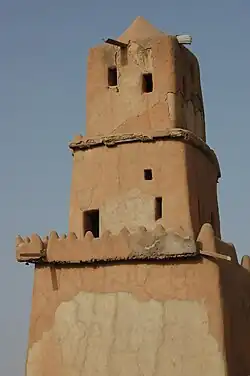Gobarau University
The Gobarau University (var. Gobirau, Goborau) is a 15-metre (50 ft) minaret located in the center of the city of Katsina, northern Nigeria. It was built in the mid 15th century. it serves as a mosque as well as a University. Some of its graduates late became scholars, scientists and theologicians of international repute. Such scholars include the 17th century mathematician, Muhammad Ibn Muhammad Al-Fulani Al-Kishwani, writer, Wali Danmasani, as well as Muhammad Al-Sabbagh (Wali Danmarina) . The architecture of the university resembles that of the fourth oldest university in the world, Sankore Madrasah in Timbuktu. Coincidentally both Sankore and Gobarau serves as mosques and a learning centre.[1] It became an important centre for learning, attracting scholars and students from far and wide, and later served as a kind of university.[1]
| Gobarau Minaret | |
|---|---|
 | |
| General information | |
| Location | Katsina |
| Country | Nigeria |
| Height | |
| Architectural | Hausa Architecture |

As an early example of Muslim architecture in a city known as a theological center, the tower has become a symbol of the city.
History
The Gobarau minaret (in Hausa, Hasumiyya) is a 50-foot edifice located in the center of the city of Katsina, the capital of Katsina State.The minaret is part of a mosque which was built in the fifteenth century during the reign of Sarkin (King) Katsina, Muhammadu Korau (1348 – 1398 AD)[2] who was the first Muslim ruler of the ancient Kingdom of Katsina. The mosque's origin is attributed to the efforts of the influential Islamic scholar Sheikh Muhammad Abdulkarim Almaghili. Almaghili, who was born in Tlemcen in present-day Algeria, taught for a while in Katsina when he visited the town in the late fifteenth century during the reign of Muhammadu Korau. The Gobarau mosque was built to serve as a center for spiritual and intellectual activities. It was inspired by mosques found in the city of Timbuktu at the time.[3]
The mosque was later used also as a school. By the beginning of the 16th century, Katsina had become a very important commercial and academic center in Hausaland, and Gobarau mosque had grown into a famed institution of higher Islamic education. Gobarau continued to be Katsina's Central mosque until the beginning of the 19th century AD when Sarkin Katsina Ummarun Dallaje (1805-1835) built a new mosque, which was later demolished by Muhammadu Dikko (1906–1944), who built the famous Masallacin Dutsi (Katsina Grand Central Mosque/Masallacin Juma'a na Kofar Soro), which is still used up to this day.
The mosque and its tower were renovated by Sarkin Katsina Muhammadu Kabir Usman (1981–2008).
Mythology
A popular myth about the origin of Gobarau states that when Muhammadu Korau slew Jibda-Yaki Sanau, the last pagan king of Katsina, he desired to construct a mosque. After the site was selected, there arose the problem of the direction of the Qiblah where the mosque must face. Muhammadu Korau consulted the Muslim scholars of that time, and they all agreed to a certain direction, except one Mallam Jodoma, a Fulani man who was a stranger. An argument broke out, and the other scholars insulted Jodoma of being a stranger who wanted to bring instability. Incensed, Mallam Jodoma pointed his staff at another direction, and there appeared the Ka'abah clearly. The tower was also used for spotting invading armies.
Muhammadu Korau was amazed, and made Mallam Jodoma his Chief Imam, much to the dismay of the other scholars, who jealously made Muhammadu Korau believe that Jodoma, becoming increasingly famous, wanted his throne. Jodoma was banished from Katsina, and he settled at Guga, a village in present-day Bakori Local government in Katsina state, where he died.
Alumni
Muhammad Ibn Muhammad Al-Fulani Al-Kishwani, Mathematician, Astrologer, Mystic
Wali Danmasani
Wali Danmarina
Tourism
Today Gobarau is a tourist attraction site, along with the Kusugu well in Daura.
References
- "The gobarau mosque and its role as a center of Islamic learning in Katsina". search.emarefa.net. Retrieved 2023-06-17.
- "About Us | Ministry Of Education Katsina". moekatsina.com. Retrieved 2023-06-17.
- Shema, Abdulsalam. "ARCHITECTURAL HERITAGE AND CONSERVATION SITE, KATSINA GOBARAU MINARET".
{{cite journal}}: Cite journal requires|journal=(help)
- "Gobarau Minaret." Encyclopædia Britannica. 2008. Encyclopædia Britannica Online. 24 Sept. 2008.
- Gobarau Minaret, the living past of Katsina, OSA AMADI, Business Day Nigeria, 12 September 2008.
- Trip to Yar’Adua’s Village, MAURICE ARCHIBONG, Daily Sun, Nigeria, August 7, 2008.
- http://www.katsinaemirate.org Retrieved 8 Apr. 2011.
- https://web.archive.org/web/20111114170909/http://www.katsinaemirate.org/earlykt.htm Retrieved 8 Apr. 2011.